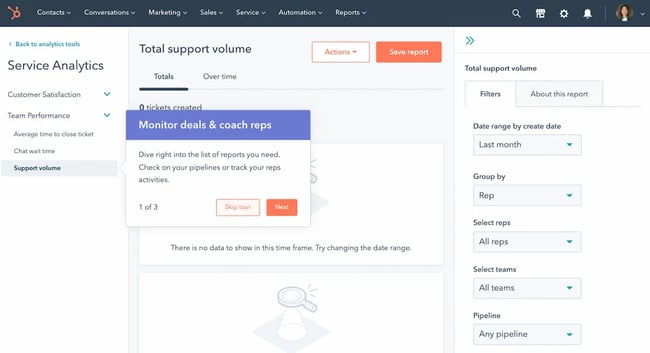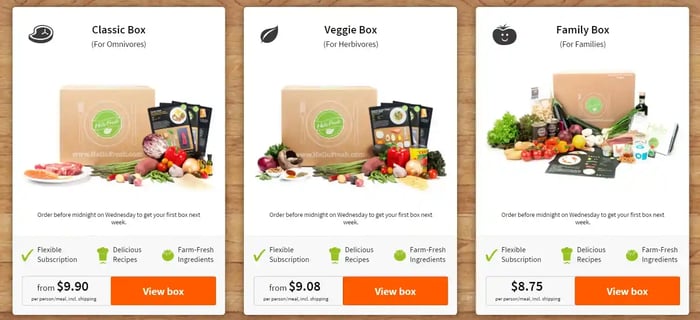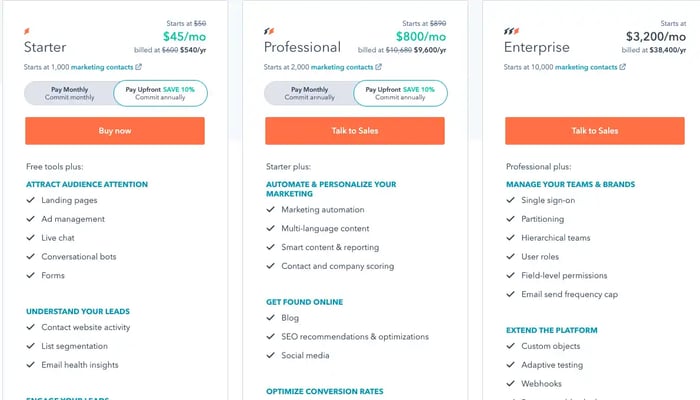Subscription business models are beneficial for many organizations because they encourage customer success and improve buyer retention.

Nowadays, subscription models are used in nearly every industry. Growing companies like Netflix, Dollar Shave Club, and Microsoft have been using a subscription-based revenue model for years with much success. The good news? Your company can, too.
In this post, let's discuss what a subscription business model is, how it works, and the benefits of using this model. Then, we'll list a few examples of subscription models that you can use as inspiration for your business.
What is a subscription business model?
A subscription business model is a recurring revenue model in which customers pay a weekly, monthly, or yearly fee in exchange for your products or services. Customers can renew their subscription after a certain period of time. This model allows you to leverage your customer relationships to create a steady stream of income.
Subscription-based revenue models benefit both the company and the customer. As a customer, you have the convenience of automatically repurchasing a product or service that you know you're going to need in the future. As a business, you retain customers for future sales rather than needing to re-engage them on a more frequent basis. You secure monthly recurring revenue (MRR), which can keep your business afloat throughout the worst times.
For the right product, brand, and industry, a subscription model can be a very effective and lucrative approach to running your business. For example, you could build a subscription box business that makes millions per year with the right marketing.
To aid with subscription billing, you can leverage tools such as HubSpot's Payments software. You'll be able to collect ACH or credit and debit card payments in one CRM.
Let's learn a little bit more about how this business model works in the next section.
How a Subscription Model Works
In a subscription model, customers are charged on a recurring basis for a product or service. They choose how long and how often they want to receive each offer, and most subscriptions provide the option to renew or cancel at any time.
Think of a subscription as a contract between you and the customer. The customer agrees to pay for a product or service for a period of time and the business fulfills that offer so long as the customer completes their recurring payments. When the contract is up, the customer has the option to renew or cancel their subscription.
The diagram below illustrates what this looks like.

A great example is your local newspaper. While you can buy newspapers individually, most who read them have a subscription. That way, you get a newspaper delivered to your front door for a fixed rate, rather than having to go to the store to purchase one.
Let's explore more benefits of subscription models in the next section.
Benefits of a Subscription Business Model
- Subscription models are convenient for customers.
- Customers can discover new products.
- Businesses can accurately predict revenue.
- Subscriptions can attract more customers.
- Subscriptions decrease customer acquisition costs.
- Businesses build stronger relationships with their customers.
1. Subscription models are convenient for customers.
People are busy. And, if they can get a product (that they like) delivered when they need it, with little to no effort on their part — sign them up. Subscriptions save people from having to research new products and shop for them in stores, creating a more seamless customer experience.
2. Customers can discover new products.
Not only do people save money from not having to travel to the store, but they also get to try new items that they may not have purchased on their own.
Take Snack Crate, for example, where you can purchase boxes of snacks from around the world. With this subscription, you might discover a new favorite snack that you never knew existed.

3. Businesses can accurately predict revenue.
Subscription models make it much easier to predict how much revenue your business will receive each month. Since your customers are paying repeatedly, you know when they're going to make a payment and how much it will be for. When you're factoring budget into your business strategy, this will help you have an accurate representation of your company's resources.
4. Subscriptions can attract more customers.
Sometimes, the price tag on a product or service can be cost-prohibitive for a consumer. Charging weekly, monthly, or annually allows you to set the price at a more affordable point, and lets consumers budget it into their monthly bills.
Think about buying a car. If you don't purchase it outright, you'll likely be put on a payment plan where you'll pay incrementally over time. This allows you to afford the cost of the car, even though you can't afford the total cost of it right away.
5. Subscriptions decrease customer acquisition costs.
Rather than engaging potential customers who don't know or trust your brand, subscription business models allow you to do business with people who already do. This cuts down on marketing costs and allows you to focus more on customer referrals. This word-of-mouth marketing is typically more effective and less expensive than promotional advertising.
6. Businesses build stronger relationships with their customers.
Another benefit of working with the same customers is that you develop stronger relationships with them over time. When your service team is always there providing excellent customer support, customers learn to trust your employees and they become accustomed to working with your brand. This plays an important role when customers have to decide whether or not they'll renew their subscription.
Now that you know the benefits of a subscription business model, let’s take a look at the steps you can take to build one for your company.
How to Build a Subscription Model
- Figure out if your business would benefit from offering subscriptions.
- Establish a goal for your subscription-based business.
- Choose a subscription pricing strategy.
- Improve the user experience to get more sign-ups.
- Create a seamless onboarding experience.
- Make the billing process simple and easy.
1. Figure out if your business would benefit from offering subscriptions.
Before creating subscription packages for your company, figure out whether offering subscriptions makes sense for your products and services. Do you sell products that customers need to continuously access? Examples would include software products, continuous services (such as consulting or content writing), and exclusive media.
Or is the product a physical item that customers will need refills for? Day-to-day products, books, and snacks might qualify here. Once you’ve figured out whether your products and services would benefit from a subscription model, move on to step two.
2. Establish a goal for your subscription-based business.
The right goal will guide your process when you’re creating subscription packages and pricing levels. For instance, are you more interested in attracting high-value clients such as enterprise businesses, or do you want to increase your small-business client base? Or maybe you want to boost sales for a certain product, grow revenue by a certain percentage, or increase customer retention.
Depending on your goals, you’ll choose a pricing structure that can help you attract the clients you want to retain. It will also help determine the right wording for your website copy.
3. Choose a subscription pricing strategy.
Depending on the nature of your product and your goals when creating your subscription model, you might select a certain subscription pricing strategy. For instance, if your goal is to sell more user seats, you might go for a per-user pricing model that provides a subscription discount to businesses that have more users.
Next is the fun part: Creating your subscription packages and levels. If you want to keep it simple, you can start by creating just one package that jumpstarts your subscription-based revenue model. As you gather more feedback from your customers and learn more about their preferences, you can create different packages that serve different segments.
4. Improve the user experience to get more sign-ups.
Signing up for a subscription package should be easy, straightforward, and simple. You don’t want your customers to wonder how they can sign up for a subscription once they get to your website and social channels. Include a call-to-action button on the top right-hand corner of your home page and above the fold, like HubSpot does below:

Once prospects get to the pricing page, they should know which package they should choose based on the language and pricing for each subscription level. (Hot tip: Check out some excellent pricing page examples to inspire your own.)
If there’s any confusion, then there should be an option to get in contact with your team via live chat or email. You certainly don’t want confusion to be a barrier to conversion.
5. Create a seamless onboarding experience.
The onboarding process will look different depending on the type of product you’re selling. For instance, if you’re selling software, the onboarding process might happen in-app with cues, like in HubSpot’s service software:

Look at the box that says “Monitor deals & coach reps.” This little box gives a tour of the information you’ll find on the page.
If you sell a physical product, the onboarding experience might be done over email or mail. You might send customers a welcome message with resources or a package with goodies.
Here are some resources for onboarding:
- The Ultimate Guide to Customer Onboarding
- How to Onboard New Clients
- How to Create an Email Onboarding Sequence
- How to Streamline User Onboarding (Recommended Read for SaaS Businesses)
6. Make the billing process simple and easy.
With your well-designed packages, excellent onboarding, and strong customer service, you’re sure to have some renewals. So you want to make sure that your billing system is set up to easily accept and process recurring payments.
To do so, you can use HubSpot's payments tool to easily collect payments, including those that are recurring. No coding knowledge is required to get started.
-1-1.webp?width=700&height=445&name=1188x756%20Summary%20%20Contact%20Info%20and%20Thank%20you!%20(1)-1-1.webp)
Get started with accepting payments with HubSpot's payments tool.
You should have a payment gateway right on your website or app so that your customers don’t have to navigate to a wide variety of links to renew their subscription. A renewal is a chance to build an even stronger customer relationship and provide additional value to your customers. You might even consider tossing in extra goodies or exclusive features for customers who’ve been with you for a long time.
Now that you know how to build a successful subscription business model, let's look at a few companies who’ve launched profitable subscriptions.
Examples of Subscription Business Models
Subscription Box Business Model
Subscription boxes have become a very popular type of business model. Every month, customers receive a box filled with various products that are sometimes related to each other and sometimes not. The combined cost of these items typically outweighs the overall cost of the box.
Some companies let the customer choose what's in the box, while with others, customers get the element of surprise while experiencing new products they may not have sought out on their own. This is a great way for a brand to familiarize its customer base with all of its products.
Subscription Box Example: Butcher Box

Butcher Box is a subscription box service that sends customers boxes of meat each month. Each box includes different cuts of meat as well as a few recipes for you to cook them with. This is a great way for carnivores and BBQ enthusiasts alike to try out different types of meat they may not have tasted or cooked before.
Streaming Service Subscription Model
Streaming services grant you access to things like movies, television, and music, for a monthly price. The benefit of this model is that consumers can access all of the entertainment content they need whenever and wherever they want.
Streaming Service Subscription Example: Hulu

Hulu is a popular streaming service that allows you to stream movies and TV shows from your computer, phone, or smart device. You can also access content on the go, so you can enjoy your favorite shows even when you're not at home. With its flexibility and competitive pricing, Hulu has become a preferred entertainment alternative for cord-cutters looking to move away from cable TV.
Food Service Subscription Model
If you're looking to mix up your dining routine, then you may want to consider a food service subscription. These companies not only deliver food to your doorstep, but they also provide you with recipes to cook with. That way, you're getting both the ingredients and direction needed to make a home-cooked meal — even if you don't have any cooking experience.
Food Service Subscription Example: HelloFresh

HelloFresh is a food subscription service that delivers all of the ingredients needed to cook a complete meal. Each box includes individually wrapped packages of food — with each one measured out to the exact portion needed in the recipe. HelloFresh saves you time from having to do prep work since all of your ingredients are measured and prepacked when you receive the box.
Health and Wellness Subscription Model
Tired of going to the gym for your daily workout? With a health and wellness subscription, you can get access to classes, trainers, and workout equipment all for a monthly fee.
Health and Wellness Subscription Example: Yoga International

Yoga International is an online yoga studio where you can attend interactive workout classes from the comfort of your home. Rather than having to adhere to a gym's set schedule, you can choose when and where you want to work out.
SaaS Subscription Model
SaaS subscription models are maybe the most common type of subscription model in the market right now. Google Workspace, HubSpot, Adobe, and Slack all have subscription models, meaning that you pay a monthly fee to have access to their software. If and when you stop paying, you only have access to the software until the end of the billing period.
Many software companies use subscription models because they often update and improve their products and services regularly. Rather than asking customers to repurchase the product every time a change is made, they use a software subscription model, which lets them make improvements without hindering the customer experience.
SaaS Subscription Example: HubSpot

All of HubSpot's products are offered on a subscription basis. And, this makes sense, too, since HubSpot routinely updates and improves its products daily. If they weren't offered as a subscription, HubSpot would have to update its pricing every day to reflect the changes made to its product. Not only would this be confusing for HubSpot, but its customers would be wondering why different customers are paying different prices for the same products.
A Subscription Business Model Will Help Your Business Grow
This is just a small taste of the industries benefiting from a subscription-based business model. With a little creativity and the right plan, you may find that this approach leads to happier customers and greater retention rates for your business as well, allowing you to grow exponentially.
Editor's note: This post was originally published in December 2020 and has been updated for comprehensiveness.
![→ Download Now: The State of Customer Service [Free Report]](https://no-cache.hubspot.com/cta/default/53/9c545446-aacf-47a3-bfb3-1998f78b79c8.png)




-1.png)
![How to Build a Strong Customer Referral Program in 2023 [Ideas & Examples]](https://blog.hubspot.com/hubfs/customer-referral-program_20.webp)
![Customer Acquisition Cost: How to Calculate CAC [+Benchmarks & Formulas to Know]](https://blog.hubspot.com/hubfs/Customer-acquisiton-costs.jpg)

![How to Ask for a Referral From a Client [+ Best Email Templates]](https://blog.hubspot.com/hubfs/referral-FI.jpg)

